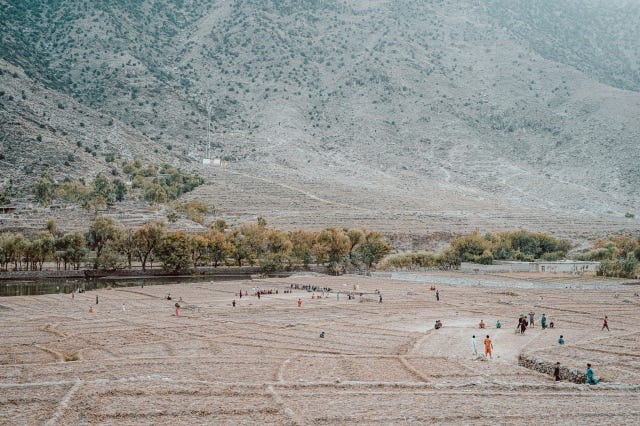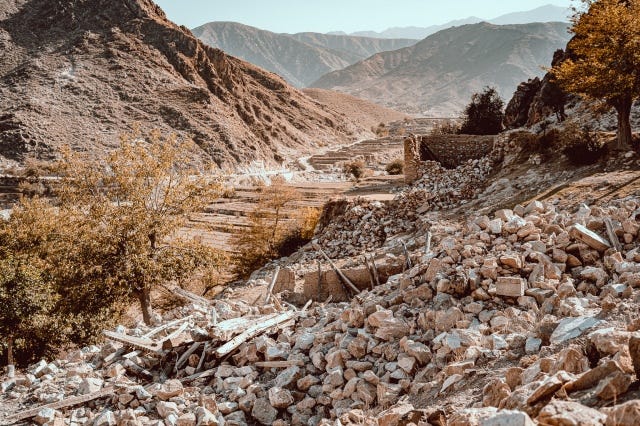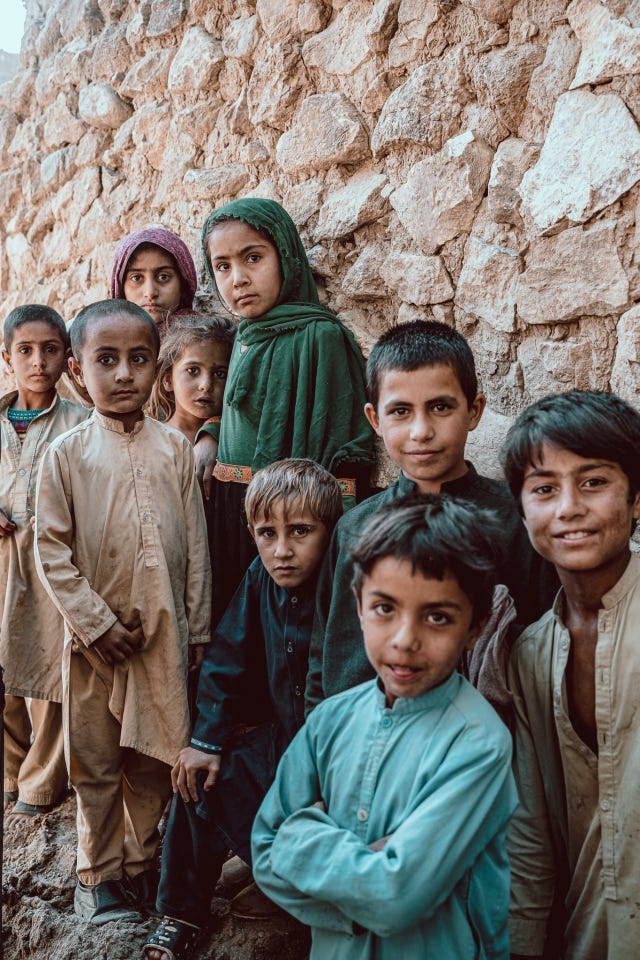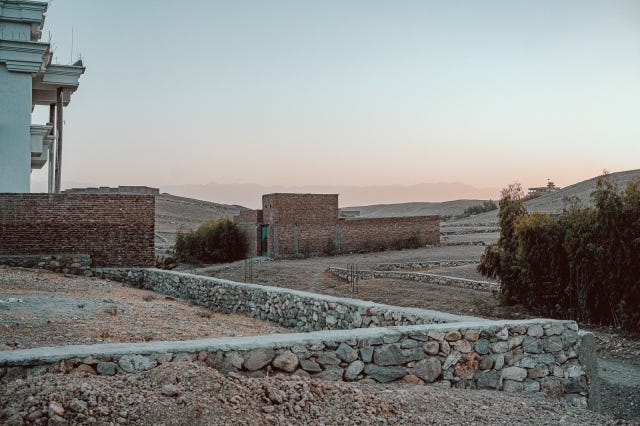Editor’s Notes: A technical issue with the audio recording for this dispatch may cause it to cut off intermittently beginning at the 6:58 minute mark. Also, there is an additional link to a 52-minute podcast Hollie did with “The You Project” in Australia at the end of this edition.
Dispatches from Afghanistan: Exclusive interview with an ISIS-K fighter to the “Mother of All Bombs” aftermath and latest on girls’ education
“In 2001, Afghanistan was a totalitarian nightmare a land where girls could not go to school, where religious police roamed the streets, where women were publicly whipped, where there were summary executions in Kabul's soccer stadium.”
— "President Bush Discusses Progress in Afghanistan, Global War on Terror"
After a long past week of travel to an array of eastern provinces, it is always nice to come “home” to the relative functionality of Kabul and the little things like a working heater as the temperature drops – even if the electricity situation is continuously arbitrary.
Much of my past couple of weeks have been spent really deep-diving into the ISIS-K threat, and what that means for Afghanistan and my beloved U.S. and her allies. The top echelons of the Taliban appear to be on the drive to convince themselves and the international community that the threat simply does not exist. Almost all the high and low ranking Talibs I speak with insist that all the perpetrators have been rounded up and sent to Central Command in Kabul, and there is nothing more to be concerned about.
Some of the Taliban’s intelligence leaders even told me that they no longer refer to the Daesh (as ISIS is known colloquially) by such names, and instead use the term “rebels.” Yet, the situation on the ground tells a starkly different story. Especially in and around the Nangarhar capital of Jalalabad, bodies are being decapitated and strung up for all to see on a daily basis, often with a stamped letter warning that if anyone comes to collect the dead they will be in trouble.
I’ve also learned that ISIS did have significant control of various villages for extended periods throughout the past six years. This includes Kunar’s rugged Korengal Valley where ISIS set up its own brutal governance structure for about six months in 2019. The Taliban commanders like to tell you that they were the ones to drive the black-clad army out, only locals later tell me in confidence that it was the Afghan National Army (ANA) soldiers and wildly independent tribal leaders that did the heavy lifting.
Still, the threat – however much the Taliban wants to downplay it – remains.
If you are interested in learning more about the aftermath of war and the ISIS ideaology, please pick up a copy of my book “Only Cry for the Living: Lessons from Inside the ISIS Battlefield.”
ISIS-K FIGHTER HIDING IN AFGHANISTAN REVEALS THE TERRORIST GROUP’S CROSS-BORDER AMBITIONS
He looks like any other ordinary young Afghan: a dusting of a dark beard, sun-leathered face, a small child clinging to the side.
Only Nazifullah, 24, is a proud member of Afghanistan’s ISIS affiliate, known as ISIS-K or informally as Daesh. He has long been wanted by everyone from U.S. troops and the now-defunct Afghan Security Forces and the Taliban, formally known as the Islamic Emirate of Afghanistan.
Yet Nazifullah lives freely in a simple wooden house by the roadside of the Dara-I-Pech district in the country’s eastern Kunar province, with his wife, 17-month-old daughter and extended family, even as Taliban operatives linger near checkpoints less than a few hundred feet away.
Nazifullah, who hails from Kunar province, says he joined the terrorist group around five years ago, out of frustration that the Taliban was dishonest about the status of its shadowy leader.
“We kept asking the Taliban to show us a video of Mullah Omar, but we couldn’t get any,” he claims. “That is why the Daesh here was created. They seemed truthful, and said they were going to implement Shariah Law, so that is why I joined them.”
Taliban founder Omar died in 2013, yet it was kept secret for more than two years. Even now, the Taliban is keeping their Supreme Leader Haibatullah Akhundzada deep in the shadows. Photos of him circulating the internet are years old, and he is yet to make any public appearance or statement – sparking questions over his state and status.
Nazifullah says he is unclear how many ISIS-K members are hidden inside Afghanistan. He spent the last year locked away in the country’s notorious Bagram prison, having been arrested by the previous Afghan government for his ISIS membership. However, when the Taliban swept to power in August, he says he was released – even though the new regime was aware of his checkered past.
Nazifullah went straight back to the black-clad terror clan but says he has since broken his leg – seemingly from an accidental discharge from his own rifle. Yet, he remains ready to take up arms again, with a very specific goal in mind.
“Our first target is to destroy Pakistan because the main reason for everything in Afghanistan is Pakistan,” he vows.
CLICK TO READ MORE OF MY INTERVIEW WITH AN ISIS-K FIGHTER
WHAT BECAME OF THE 'MOTHER OF ALL BOMBS' AND THE TARGETING OF THE ISIS-K AIRPORT ATTACK IN AFGHANISTAN
A shallow crater spawns the earth as far as the eye can see. The mammoth hole – 40 miles from the provincial capital of Jalalabad – is now stuffed with ancient stones and surrounded by tufts of green, mud homes and crinkled, curious faces coated in dust and squinting in the blinding light.
Some four-and-a-half years ago, the United States – under the direction of President Trump – dropped the almighty, 21,600-pound, guided “mother of all bombs” (MOAB) over an Islamic State cave composite traversing the Achin and Spinghar districts in the eastern Afghanistan province of Nangahar.
It was poised to cripple the then-emerging Afghanistan ISIS affiliate from its power base in the eerily quiet terrain. Unlike conventional bombs, the MOAB is designed to infiltrate a building or the ground spanning nine city blocks, blasting fuel into the air, triggering a secondary detonation that ignites the atomized fuel.
“U.S. forces took every precaution to avoid civilian casualties with this strike and will continue offensive operations until ISIS-K is destroyed in Afghanistan,” the Department of Defense said in a statement at the time.
Villagers left in the rugged terrain complain of health ramifications, but almost all begrudgingly admit that dozens of ISIS – colloquially known as Daesh – fighters were slain.
“As soon as the bomb was dropped, all the Daeshs were killed, so people could live in this area. People started coming back. Before that, we couldn’t live here. But now there are chemicals here,” says local labor worker Qari, who thinks he is around 50 years old. “It was a test bomb, but it killed some Daesh here. Houses were destroyed, but nobody was left here. Now (the people here) have problems.”
Others say that their children – born less than a year ago – suffer severe digestive ailments, which the doctors attribute to “the chemicals from the bomb.”
Locals are quick to pull up their clothing to reveal bright red, angry streaks across the flesh of their stomachs. Children, who play in and around the carved parcel of dirt, scratch at roughened red bumps oozing from their clay-caked faces. It is impossible to know precisely the cause of their distress, but locals repeatedly insist that the ailments only began in the bomb’s aftermath.
But what is worse, many say is that they can no longer grow enough crops to make even a basic living.
However, the unspoken woe now is that it may have been all for nothing.
The U.S chaotically exited the country just over two months ago, seemingly well before the job was complete. Making matters worse, the terrorist outfit last year executed a raid on a prison in Nangahar’s capital Jalalabad, enabling dozens of the most hardcore of its ranks to flee.
It is becoming jarringly clear that ISIS-K is only expanding its insurgency footprint countrywide.
Given the spate of attacks that have occurred since the Taliban formally seized the Presidential reigns on August 15 – most notably the brutal bomb attack on the periphery of Hamid Karzai International Airport (HKIA) in the dwindling U.S. days, which claimed the lives of thirteen American military personnel– it’s a group that is becoming too hard for the new regime, and subsequently, the United States and her allies, to entirely ignore.
On the eerily quiet periphery of Jalalabad city, through snaking dusty roads, a simple brick home with a blue-green door – at first glance – seems untouched. But edge a little closer, and it is evident that a significant hole has guttered a targeted spot in the infrastructure.
In late August, the humble home was struck by a U.S drone – purportedly taking out the alleged ISIS-K mastermind of the August 27 HKIA attack.
One guard for a house across from the target, Samiullah, recalls standing on the roof late at night when the U.S drone hit. He recalls the screaming of women and children and confirms that only the main target – a man they never really saw – was the only person killed.
Three decapitated bodies, presumably of Taliban fighters, were also left in their wake.
“In a stamped letter next to the bodies the Daesh they had written whoever picks up these bodies will be in trouble,” Samiullah continues nervously. “The bodies were rotting there for two days, and after that, someone from another area came and collected them.”
CLICK TO READ MORE ABOUT THE MOAB AFTERMATH AND RISE OF ISIS-K…
Lastly, it is always an honor to chat to the Aussies. Thoroughly enjoyed this podcast with “The You Project.” You can listen in here…
Thanks again for your support!
Follow me on Instagram and Twitter for more updates
Photos courtesy of my brilliant photographer @JakeSimkinPhotos. Please consider a paid subscription to allow us to continue this work.




















Share this post